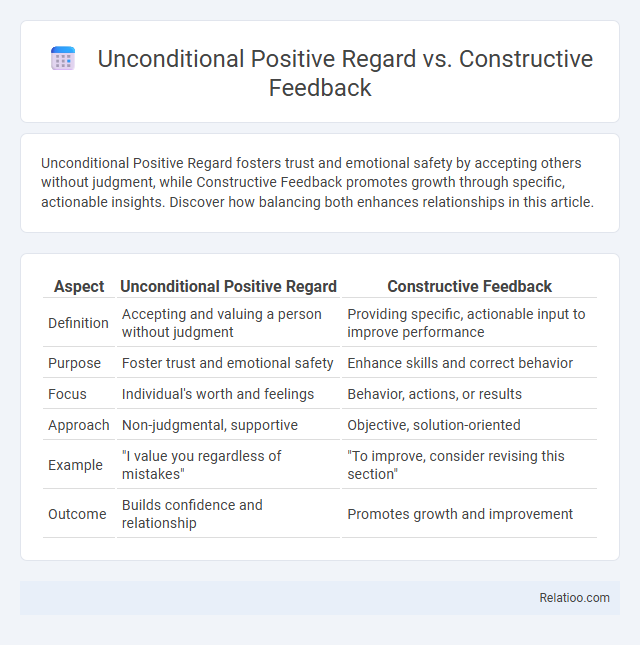Unconditional Positive Regard fosters trust and emotional safety by accepting others without judgment, while Constructive Feedback promotes growth through specific, actionable insights. Discover how balancing both enhances relationships in this article.
Table of Comparison
| Aspect | Unconditional Positive Regard | Constructive Feedback |
|---|---|---|
| Definition | Accepting and valuing a person without judgment | Providing specific, actionable input to improve performance |
| Purpose | Foster trust and emotional safety | Enhance skills and correct behavior |
| Focus | Individual's worth and feelings | Behavior, actions, or results |
| Approach | Non-judgmental, supportive | Objective, solution-oriented |
| Example | "I value you regardless of mistakes" | "To improve, consider revising this section" |
| Outcome | Builds confidence and relationship | Promotes growth and improvement |
Understanding Unconditional Positive Regard
Understanding Unconditional Positive Regard involves accepting and valuing a person without judgment, fostering a safe environment for personal growth. Unlike Constructive Feedback, which aims to improve behavior or performance through specific suggestions, Unconditional Positive Regard emphasizes empathy and genuine care regardless of actions or outcomes. Your ability to genuinely practice this creates trust and encourages authentic self-expression, essential in therapeutic and personal relationships.
Defining Constructive Feedback
Constructive feedback is specific, actionable information aimed at improving performance or behavior by highlighting strengths and areas for growth without judgment. Unlike unconditional positive regard, which involves accepting and valuing a person without conditions, constructive feedback focuses on behaviors rather than inherent worth. This approach fosters development while maintaining respect and support in relationships or professional settings.
Core Principles of Unconditional Positive Regard
Unconditional Positive Regard centers on accepting and valuing individuals without judgment, fostering a safe environment for personal growth. It emphasizes empathy, genuineness, and non-judgmental support, distinguishing it from Constructive Feedback, which focuses on specific behavior improvement and guidance. Core principles of Unconditional Positive Regard include respect for the person's inherent worth, unconditional acceptance regardless of actions, and fostering self-acceptance and psychological safety.
Essential Elements of Effective Feedback
Effective feedback hinges on clarity, specificity, and a supportive tone that fosters growth while maintaining the recipient's dignity. Unconditional Positive Regard emphasizes acceptance and support without judgment, creating a safe environment for development. Constructive Feedback combines honest appraisal with actionable suggestions, balancing encouragement and improvement to drive performance and learning.
Benefits of Unconditional Positive Regard in Relationships
Unconditional Positive Regard fosters trust and emotional safety by accepting individuals without judgment, promoting deeper connections and self-esteem in relationships. Constructive Feedback offers growth opportunities through specific, actionable suggestions, but may not always create the same emotional security. Prioritizing Unconditional Positive Regard enhances compassion, reduces defensiveness, and strengthens bonds by valuing the person's inherent worth regardless of their behavior.
Advantages of Constructive Feedback in Personal Growth
Constructive feedback fosters personal growth by providing specific, actionable insights that help individuals identify areas for improvement and develop new skills. Unlike unconditional positive regard, which offers acceptance regardless of performance, constructive feedback challenges individuals to reflect critically and make meaningful changes. This targeted approach accelerates learning processes and enhances self-awareness, leading to sustained personal development.
Key Differences: Unconditional Positive Regard vs Constructive Feedback
Unconditional Positive Regard involves accepting and valuing a person without judgment, fostering trust and emotional safety, whereas Constructive Feedback targets specific behaviors or performance, providing actionable suggestions for improvement. The key difference lies in the focus: Unconditional Positive Regard emphasizes unconditional acceptance of the individual, while Constructive Feedback emphasizes growth through critical evaluation. Both are essential in communication, but serve distinct roles in supporting personal development versus emotional support.
Integrating Both Approaches in Communication
Integrating Unconditional Positive Regard with Constructive Feedback fosters a communication style that balances empathy and growth, ensuring your message is both supportive and clear. This approach validates the individual's worth while offering specific, actionable insights for improvement, enhancing motivation and trust. By combining acceptance with targeted guidance, you create a psychologically safe space that encourages openness and development.
Challenges in Balancing Acceptance and Critique
Balancing unconditional positive regard and constructive feedback presents challenges in maintaining genuine acceptance while fostering growth. Unconditional positive regard emphasizes empathy and non-judgmental support, but can risk enabling complacency if critique is insufficient. Constructive feedback requires careful delivery to ensure it motivates improvement without undermining self-worth or trust, highlighting the delicate interplay between acceptance and critique in effective communication.
Best Practices for Fostering Growth and Emotional Safety
Unconditional Positive Regard creates a foundation of emotional safety by accepting and valuing Your feelings without judgment, fostering trust and openness essential for personal growth. Constructive Feedback, delivered with empathy and specificity, supports Your development by highlighting strengths and areas for improvement while maintaining respect and encouragement. Combining both approaches ensures growth is nurtured in an environment of safety, where Your self-worth is affirmed, and challenges are viewed as opportunities for learning.

Infographic: Unconditional Positive Regard vs Constructive Feedback
 relatioo.com
relatioo.com